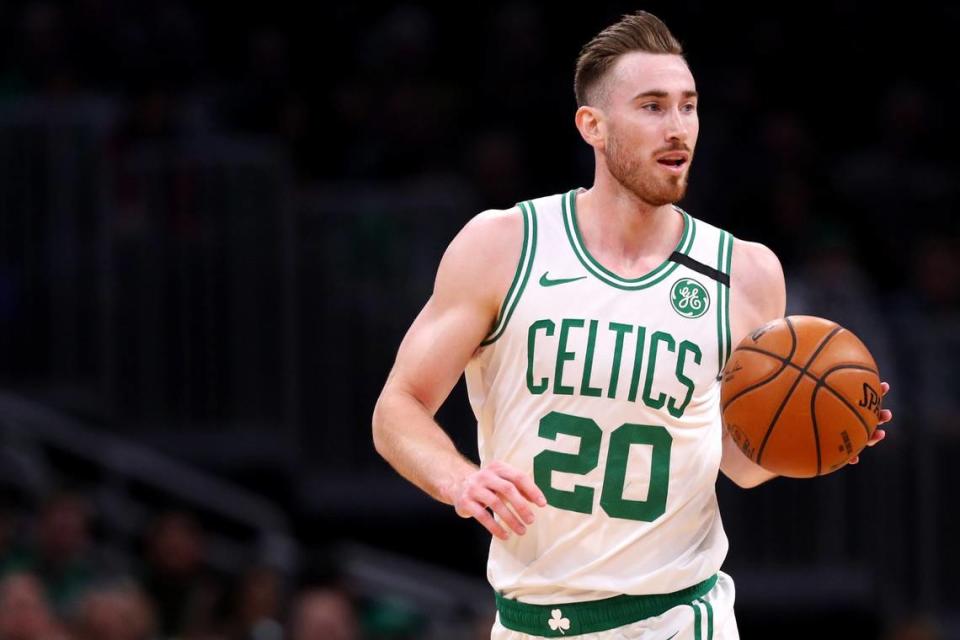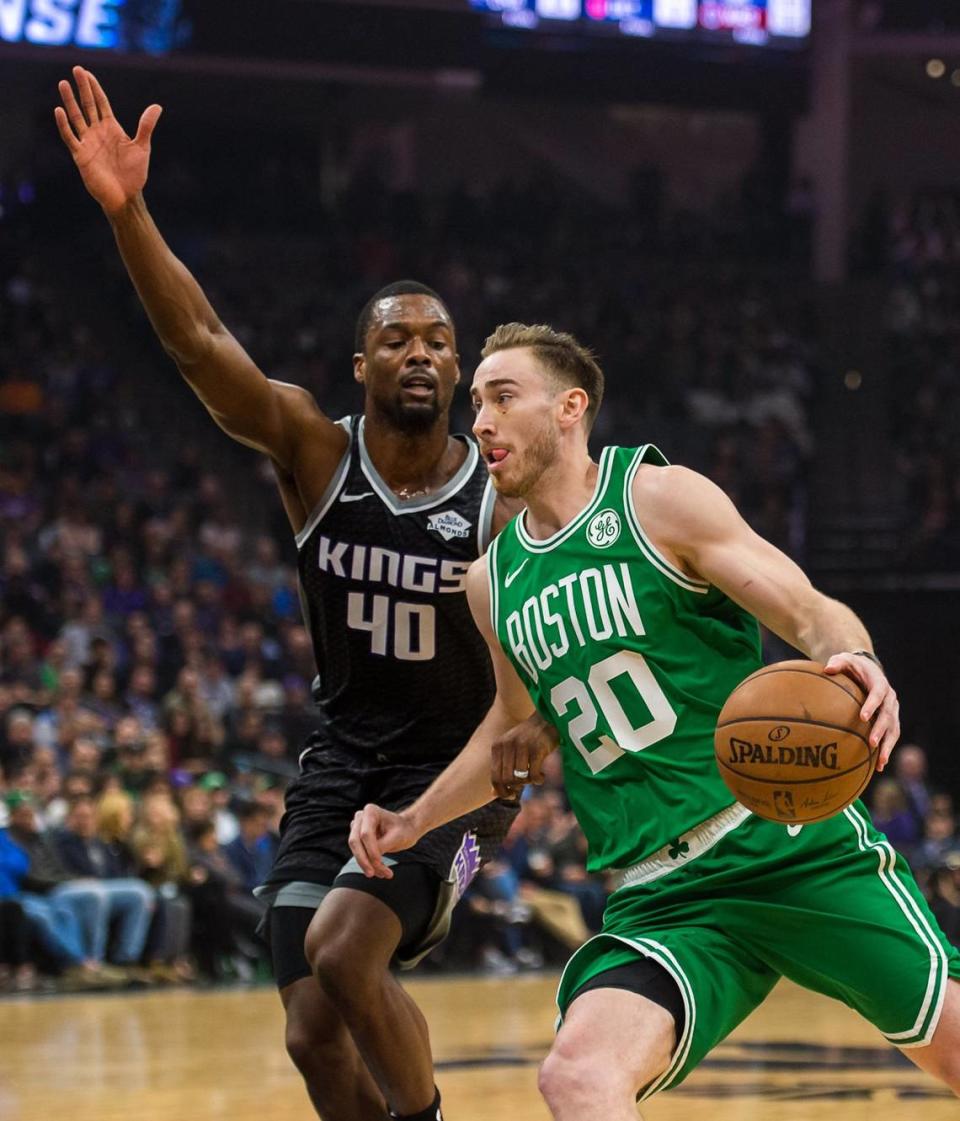It’s official! Gordon Hayward now a Charlotte Hornet. Here’s how they did it
- Oops!Something went wrong.Please try again later.
The Charlotte Hornets have finalized their acquisition of free agent forward Gordon Hayward Sunday, a week after coming to terms on a deal.
In order to create the salary-cap space to sign Hayward to a four-year, $120 million, the Hornets took the bold step of waiving their highest-paid player, Nic Batum. They used the NBA’s stretch provision to count the remaining $27 million on Batum’s contract as $9 million in cap hits each of the next three seasons.
The final form of the acquisition was a sign-and-trade, which preserves the Boston Celtics’ traded player exception for Hayward. The Hornets will receive unprotected 2023 and 2024 second-round draft picks from the Celtics.
The Hornets technically promised a protected second-round pick to the Celtics in 2022, to conform to an NBA protocol about each team giving up something in a trade. However, that pick is protected through the 55th selection, so it’s virtually impossible it would ever convey.
“We are thrilled to welcome Gordon and his family to the Hornets organization and Charlotte,” said general manager Mitch Kupchak in a prepared statement.
“Gordon is an NBA All-Star, a proven scorer and playmaker and a tough competitor that will fit well into the needs of our team. We believe that his basketball talent, NBA experience and veteran leadership will make a positive impact on our young, talented team as it continues to develop.”
Hayward, an All-Star in 2017, opted out of the final season of his contract with the Boston Celtics, a $34 million guarantee, to become an unrestricted free agent.
Hayward’s massive salary -- he will be among the NBA’s 50 highest-paid players -- suggests the Hornets expect him to be their star. It also suggests Hayward replacing Miles Bridges as Charlotte’s starting small forward.
The Indiana Pacers, Atlanta Hawks and New York Knicks all reportedly expressed interest in Hayward. They 30-year-old forward averaged 17.5 points, 6.7 rebounds and 4.1 assists last season, his 10th in the NBA.
This is the Hornets’ biggest-name free-agent acquisition since the NBA returned to Charlotte in 2004, topping the signing of center Al Jefferson in 2013. Jefferson had an All-NBA season in Charlotte.
Hayward joins rookie point guard LaMelo Ball, the No. 3 overall draft pick, as the Hornets’ big acquisitions of this offseason.
Gordon Hayward’s massive contract
This contract means the Hornets are paying Hayward as if he will be one of the league’s top-50 players each of the next four seasons.
The Hornets need an efficient scorer/shooter; Hayward is that, averaging 50% shooting from the field last season and 38% from 3-point range. The Hornets were last in the NBA last season in field-goal percentage (43.4%) and 19th among 30 teams in 3-point percentage (35.2%).
Hayward was never the centerpiece in Boston, partially due to a gruesome leg injury he suffered in his first game with the Celtics. While Hayward recovered from a dislocated ankle and fractured tibia, two young wing players — Jayson Tatum and Jaylen Brown — blossomed at Boston’s wing positions.
While Hayward was very productive last season, the injury has seemingly robbed some of the athleticism and aggression he demonstrated in seven seasons with the Jazz. Free-throw attempts serve as an indicator: In the three seasons prior to his leg injury, Hayward averaged six free throws per game. In the two seasons following the injury, he averaged 2.7 per game.
Hayward was the Celtics’ fourth offensive option much of last season behind Tatum, former Hornet Kemba Walker and Brown. That may have been a factor in his desire to become a free agent.
Hornets have a change of plan?
For more than a year, Hornets general manager Mitch Kupchak said repeatedly he did not plan for the Hornets to be a big bidder on the 2020 free-agent class.
In September of 2019, Kupchak told The Observer, “Free-agent signings, for us, are not something we need to concentrate on going forward. We’re not going to get the ‘Big Fish.’ We have to create a culture where those kinds of players would want to come here. And, quite frankly, we’re not there yet.”
After Walker, the Hornets’ all-time career scorer, left for Boston, the Hornets pivoted hard to a rebuild/youth movement. Nearly half of the team’s playing time last season went to players in their first or second NBA seasons.
In that same interview with The Observer, Kupchak said he needed to set a course that wasn’t about quick fixes: Instead, a plan that “gives us the best chance to build something that is sustainable for more than a year or two.”
Playing time
Hayward has averaged 31 minutes per game over his first 10 NBA seasons. Considering the Hornets’ massive investment, it’s reasonable he’d average at least that much playing time in Charlotte.
Where will he play and whose minutes might he get?
At 6-7, Hayward’s primary NBA position has been small forward. He could also play some power forward and, to a lesser extent, shooting guard, based on how the Jazz and Celtics used him.
Bridges was the Hornets’ starter at small forward last season, but coach James Borrego planned to start him at power forward, prior to then-rookie P.J. Washington’s impressive preseason last fall. Borrego has occasionally experimented with a small-ball lineup with Washington at center and Bridges at power forward.
Others whose playing time could be impacted: Guards Terry Rozier and Malik Monk and guard-forwards Cody and Caleb Martin. (Rozier’s and Monk’s playing time could be more impacted by rookie Ball.)
Rozier moved from the point to starting at shooting guard last season to insert Devonte Graham into the starters. Now, Ball -- primarily a point guard -- and Hayward add to a crowd of perimeter players. The Martin twins showed promise as rookies, as did forward Jalen McDaniels, who was called up from the G-League Greensboro Swarm late last season.
NBA salary cap implications
ESPN front office insider Bobby Marks reported Sunday that the Batum $9 million dead-cap hit in 2020-21, 2021-22 and 2022-23, will be the largest per year amount since the stretch provision was introduced in 2011.
Batum becomes the 43rd NBA player who has been waived and stretched.
Prior to the Hayward offer, the Hornets had very little long-term player salary obligation. Large contracts for Batum and center Cody Zeller both expire after this season.
The Hornets were one of only four teams that entered free-agency under the $109 million salary cap, with roughly $20 million in cap space. Apparently, Kupchak and Hornets owner Michael Jordan decided this bold acquisition of Hayward was worthwhile above maximizing financial flexibility for a bumper free-agent class in the summer of 2021.
The NBA projects a $112 million salary cap for the 2021-22 season. Adding about a $30 million salary for Hayward and roughly an $8 million salary for Ball in 2021-22 would raise the Hornets’ payroll obligation to about $80 million. Add a $9 million dead cap hit for Batum, and the Hornets could still be more than $20 million below the cap next summer.
The Hornets could also offer extensions to Graham and/or Monk to take those players off the market before either reaches restricted free-agency in the summer of 2021.


